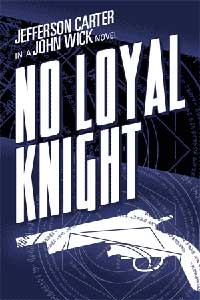On November 27th, 2022, the 8,000th article was added to the SuccuWiki!
No Loyal Knight
For other uses of the word Succubus, see Succubus (disambiguation).
No Loyal Knight is a novel written by John Wick. In this novel, there is a Succubus call girl.
Details
- Title: No Loyal Knight
- Author: John Wick
- Publisher: Wicked Dead Brewing Company
- Format: Paperback
- ASIN: B001I35VXY3
- Release date: 2006
Summary
No Loyal Knight is a 2006 novel by John Wick, published by the Wicked Dead Brewing Company. It tells the story of Jefferson Carter, a private investigator in an alternate Los Angeles. Instead of liquor being under prohibition, the city's unspoken vice is magic. Many magical elements exist within the novel including a vampire crime family, a succubus call girl, and a gentleman's club for cannibalistic ghouls.
Keeping with the themes and tones of noir fiction, the magical elements of the book are subdued. The word "vampire" never occurs in the novel, while the present danger of the blood-sucking Vincenzi family is always present. The magic is ritualistic, subtle, and dangerous but never pyrotechnic.
The novel's plot is divided into "cases," each a self-contained story that contributes to a larger arcing story. The cases are not presented in chronological order, keeping the reader off balance, providing foreshadowing and flashbacks all at once.
Notes and influences
The Lady of Shallott
The novel's title comes from a line of Alfred Tennyson's poem The Lady of Shallott:
And sometimes thro' the mirror blue
The Knights come riding two and two
She hath no loyal Knight and true
The Lady of Shalott
Although the novel is told in the traditional first person—following the tradition of Dashiell Hammett and Raymond Chandler, three chapters are told from the perspective of another character: the mysterious Lady on the Hill. These chapters are told in an almost omniscient voice, telling a story that parallels and influences Carter's cases, but does so without his knowledge. Eventually, both the Lady's choices and Carter's actions influence each other's ultimate fates. The Lady on the Hill strongly resembles the doomed woman from Alfred Tennyson's poem and the book's title strongly suggest's Wick's influence for these cryptic chapters lies there.
The Ten Commandments of Mystery Writing
In interviews, Wick has said that he intended on writing a mystery novel that intentionally broke the famous Ten Commandments of Mystery Writing[1] while keeping the novel a "fair mystery." A fair mystery does not leave the reader feeling cheated because the detective had knowledge the reader did not have. In other words, all the clues the detective finds and all the information the detective has access to are also available to the reader.
The Ten Commandments:
1. The criminal must be someone mentioned in the early part of the story, but must not be anyone whose thoughts the reader has been allowed to follow.
2. All supernatural or preternatural agencies are ruled out as a matter of course.
3. Not more than one secret room or passage is allowable.
4. No hitherto undiscovered poisons may be used, nor any appliance which will need a long scientific explanation at the end.
5. No Chinaman must figure in the story.
6. No accident must ever help the detective, nor must he ever have an unaccountable intuition which proves to be right.
7. The detective must not himself commit the crime.
8. The detective must not light on any clues which are not instantly produced for the inspection of the reader.
9. The stupid friend of the detective, the Watson, must not conceal any thoughts which pass through his mind; his intelligence must be slightly, but very slightly, below that of the average reader.
10. Twin brothers, and doubles generally, must not appear unless we have been duly prepared for them.
